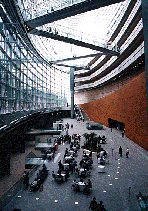
|
Aug. 6, 1996
|
Art Watch Index - Jul. 26, 1996
|
|
![]()
 Tokyo International Forum
|
Architecture built on high quality
I visited the newly built Tokyo International Forum, the architecture designed by Raphael Vignoli, who won the assignment after applying to the international competition from New York in 1988, the peak year of the "bubble economy". The municipal building is located at the Imperial Palace side of Yurakucho station, has a floor space area of 1,444,000 square meters, and covers 3 hectares of land. It is a giant complex with a multi-purpose glass hall built in a wellhole style of more than 60 meters from top to the basement floor. It has 4 auditoriums including one that has up to 5,000 seats, conference rooms, a reception hall, an exhibition hall, an information center, service facilities, etc. The building is a "Convention Art Center" and Mr. Suzuki, the former governor of Tokyo is the director. Perhaps weekly photographic magazines and newspapers will bitterly point out its high running costs, excessive luxury, and even question the necessity of such a complex. Or on the other hand, they may introduce the place favorably, as a new landmark of Tokyo, suitable as a dating spot. In any case, all reviews will be based on the standpoint of the "taxpayer" or the "consumer". However, as a designer, I must admit I am impressed with the realization of this huge architecture of such outstanding quality. The details have been so thoroughly planned and defined that various attempts are not fragmented. Rather, they are well-integrated as a whole. There is no reflection of the inner side of the architect, nor any adherence to ideas. The building is simply technology and creativity at its best -- clear, sophisticated, and truly professional. In that sense it can be said that it resembles buildings of high precision built by general contractors, but the Tokyo International Forum is full of ideas in many of its details and enjoyable from an architectural viewpoint. No detail of the building implies its social significance nor the reason why such a complex stands at this location. I could not help but be rather shocked by this. How is it possible that a building of this scale not to show any ideology? The answer must be that the architect is true to the spirit of "business". He pursued his role as an architect, doing the best in a given framework and never questioning what has been set forth. It is common that the bigger the scale of the building, the greater influence it wields over society, making it difficult for any architect to adhere to a specific ideology. The Tokyo International Forum does not attempt to please all, inadvertently leading itself into a vague existence. On the other hand, its professionalism enables it to have an abstract positioning without having to represent a specific viewpoint. Before this kind of professionalism, the works of the Japanese architects can be characterized as amateurism reflecting immaturity and imperfectionism. Perhaps these two factors tend to be justified by the Japanese sensibility which believes that certain areas must remain undefined. However, I have come to understand that what supports the amateurism of Japanese architecture is the reliability on the "meaning of architecture". I became aware of this notion through the Tokyo International Forum which had been uninterested in the "meaning of architecture" from the very beginning. [Yoshiharu TSUKAMOTO/Architect]
|
|
|
|
|
Meguro Museum of Art, Tokyo http://www.dnp.co.jp/ museum/meguro/ meguro-e.html |
A need for a genuine "introduction" of history
Possibilities enabled by confusion This exhibition focuses on the trend of the 1950's, a decade that is often forgotten, but nevertheless pivotal when talking about post-war art in Japan. The exhibition goes even further by "shedding light" to a particular year, 1953, as seen in the title, in an attempt to make a certain statement. This period of art history has often been perceived as a "prologue" of various trends in post-war art -- "gutai", "counter-art", "mono-school", "post modern" -- that derived from it. The word "prologue" may be deceiving, for its connotation is supposedly negative rather than positive. This year is interpreted as a shapeless form yet to be seen, a premature quickening stage, where confusion of the post-war era still lingers. However, in reality, 1953 contained the "developments" that were to ensue. Thus, the year was not a "quickening stage", but more of an "outcome" that is explanatory of what followed afterwards. If so, it is understandable how this exhibition, containing various viewpoints, turned out to be slightly confusing in its efforts to seek diverse possibilities from 1953, an year that seemingly had "nothing". If this exhibition's highlight is to be pointed out, it would be the possibilities emerging from "confusion". Why 1953? The exhibition covers a diverse range of subjects where each of them can be used as an independent "theme" for a separate exhibition. Although I understand that the intention of the exhibition is to focus on the diversity which became the origin of the "themes" seen in contemporary art, frankly, I grew frustrated as I observed each section. Even with the most compromising view, I cannot say the frustration is the price one must pay or is the necessary evil in order to surface the potential the year, 1953, had to offer. I could find no focus on what kind of an year 1953 was even after looking through the exhibition. The impression of the exhibition was that of a possibility amidst confusion thrown out before us without being given any "critical" perspective. The absence of a social dimension One problem is that the exhibition avoids confronting the dimension that is indispensable when trying to explain the year, 1953. The missing dimension, as mentioned in the catalogue, is no doubt the connection between art and society as demonstrated in the "First Nippon" exhibition. If the organiser thought that the "exhibition will lose its balance when the critical tone was stronger than that of an introduction", then it should have explained its "critical motive" in "excluding" the very exhibition that was the key in finding out the potentials of "1953". Because the introduction and revival performance of "Jikken Kobo" in this exhibition was a long-awaited one even considering it apart from the theme of 1953, I feel that before making the show a "critique", a genuine "introduction" of history, which must be the prerequisite to a "critique", should have been presented. [Noi SAWARAGI/Art Critic]
|
|
|
|
|
[London]
The exhibition based on the theme of [the city], <<Never Walk Alone>>, is currently being held at the Photographers' Gallery located at the Leicester Square in London. This exhibition shows works by 17 artists including Hans Aarsman, Merry Alpern, Eugene Atget, Suky Best, Don Brown, and Louis Lussier who express the city in various forms. The interesting point about this exhibition is that it goes beyond the location of the gallery. As the title indicates, a guidebook is made for the visitors so that they can travel around the city of London, and depending on the day, participate in walking tours included in the program. The show is planned so that the visitor can actually "experience" [the city]. It has been suggested by many scholars that [the city] has a strong relationship to the development of modernism. Going out of the house, becoming lost in a crowd of strangers, walking through an arcade, window shopping, enjoying tea at a cafe...hiding oneself as one of the crowd and observing the various events happening in the city are privileged enjoyments of the city-dwellers since the age of modernism, and Walter Benjamin called those who consciously engaged in such acts, a "Flâneur" ("wanderer"). According to Beaudelaire, to whom Benjamin owes much of his ideas, such people who consciously engage in such activities are noone else but "poets", and in that way, today everyone has become a "poet". This exhibition focuses on the changes of [the city] in this post-modern. According to the director, Paul Wombel, the video cameras installed all around the city have changed the nature of the city itself. If the 19th century-city had a strong connection to the development of photographic technology, the outstanding characteristic of the modern city is the video camera. What has been brought to us here is a voyeuristic interest, or a 24-hour mutual surveillance system. The people today are finding it more and more difficult to hide themselves and walk around the city as Beaudelaire did. The most impactful work in this exhibition was Merry Alpern's "Dirty Window", which is a series consisiting of voyeuristic shots from outisde the window looking onto scenes of love affairs or prostitution. Why do such kinds of photography look attractive? Will people be able to escape the temptation of voyeurism and mutual surveillance? Is it no longer possible for us to become a "Flâneur"? Coming out of the exhibition and walking along Great Newport Street, there again are video cameras installed by the gallery, constantly filming the street, constructing an ironical device in which we, ourselves, are also shown on the screen monitor exhibited in the gallery.
[Yoshitaka Mouri/Cultural Studies]
|
|
|
|
|
|
|
|
|
Aug. 6, 1996
|
[home]/[Art Information]/[Column]
[nmp Forum]
Copyright (c) Dai Nippon Printing Co., Ltd. 1996
Network Museum & Magazine Project / nmp@acs.dnp.co.jp
